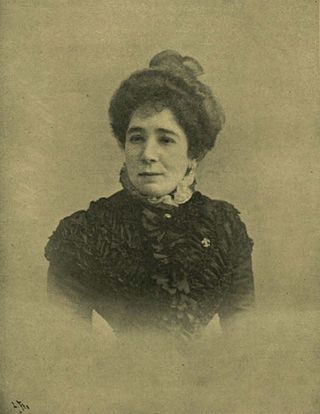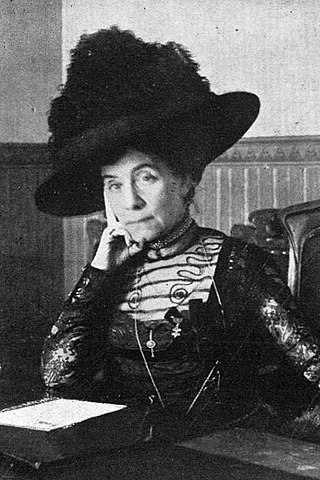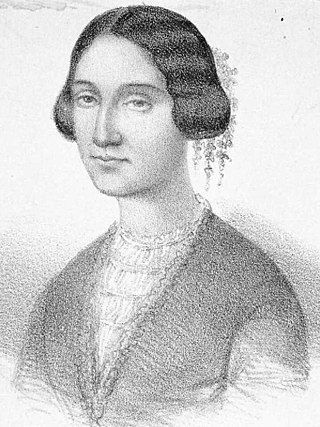Related Research Articles

Francisco López Acebal was a Spanish novelist, playwright and journalist.
José Fernández-Montesinos Lustau was a Spanish historian and literary critic belonging to the so-called Generación del 27, a generation he himself referred to as "this ill-fated, mistreated and dispersed generation of mine".

Iris M. Zavala was a Puerto Rican author, scholar, and poet, who later lived in Barcelona, Spain. She had over 50 works to her name, plus hundreds of articles, dissertations, and conferences and many of her writings, including "Nocturna, mas no funesta", build on and express this belief.

María Dueñas Vinuesa (1964) is a Spanish writer and professor. She rose to fame in 2009 with El tiempo entre costuras, her first novel, which became one of the best-selling works of Spanish literature in recent years and has been translated into more than twenty-five languages.
Maria Matilde Bianchi Prada was a Uruguayan writer.

Anna Maria Martínez Sagi was a Spanish poet, trade unionist, journalist, feminist and athlete. She was national champion in the javelin and became the first female director of a Spanish football club. During the Spanish Civil War she followed the Durruti Column as a journalist and was then exiled to France, living in different places. During World War II she joined the French Resistance and evaded capture by the Gestapo. Afterwards she worked for the Aga Khan and then moved to the United States where she taught at the University of Illinois. After the death of Francisco Franco, she returned to Catalonia where she lived in obscurity near to Barcelona.

Luz Méndez de la Vega was a Guatemalan feminist writer, journalist, poet, academic and actress. As an academic, she concentrated on researching and rescuing the work of colonial Guatemalan women writers. She was the winner of Guatemala's highest prize for literature, Miguel Ángel Asturias National Literature Prize, and the Chilean Pablo Neruda Medal, among many other literary awards throughout her career.

María Esther de Miguel was an Argentinian writer.

Faustina Sáez de Melgar, née Faustina Sáez y Soria (1834–1895) was a Spanish writer and journalist. She was mother of the composer and painter Gloria Melgar Sáez.

María Dolores de Gortázar Serantes (1872-1936) was a Spanish writer, journalist, education activist, feminist militant and political propagandist. In the 1910-1920s she enjoyed some popularity as a novelist; currently her literary contribution is considered of very little value. Over decades she contributed to some 40 periodicals and launched a short-lived feminine review on her own. Briefly engaged in setting up schools for the middle- and low-class girls, later she remained active advocating the presence of females in public life, especially in culture and education. Politically she sided with the Carlists, for decades contributing to their periodicals. All her activities were flavored with zealous Catholicism.
María Rosa de Gálvez or María Rosa Gálvez de Cabrera, was a Spanish poet and playwright during the Age of Enlightenment and Neoclassicism periods.

Sofía Casanova was a poet, novelist, and journalist, the first Spanish woman to become a permanent correspondent in a foreign country and a war correspondent. She was a cultured woman, well-known in the literary circles of the time. In her work she highlighted the human aspect of her chronicles as a correspondent for the newspaper ABC in Poland and Russia, where she reported on the suffering of the civilian population during the wars she covered, adding literary value. Her activity throughout Europe allowed her to experience events such as the First World War, the fall of Czarist Russia, the emergence of the Bolshevik regime, and the Second World War. She wrote for newspapers such as ABC, La Época, El Liberal, and El Imparcial, for the magazine Galicia, for other Galician publications, and for the international press, such as the Gazeta Polska and the New York Times. Of Catholic and monarchical convictions in the Spanish Civil War, she joined the Francoist ranks. Her long life allowed her to leave behind a broad collection of writings covering all literary genres.

Antonia Domínguez y Borrell (1831–1917) also known as the Duchess of La Torre, was a Spanish noblewoman who played an influential role in Spanish politics and society during the Sexenio Democrático. She held the nobiliary title of Countess of San Antonio.

Dolores Cabrera y Heredia was a Spanish Romantic poet and novelist. A native of Aragon, she moved throughout Spain first following her father, then her husband. She showed an early aptitude for poetry and wrote for most of her life.
Adela Galiana y Albaladejo, also known as Adela Galiana de Osterman was a Spanish writer, playwright, poet and columnist.
Manuela Villarán de Plasencia (1840–1888) was a Peruvian writer, poet, and journalist.
Sofía Tartilán was a 19th-century Spanish novelist, essayist, journalist, and editor. Her name appeared as a regular contributor to much of the high-profile press of her time.

Eva Yárnoz is a Spanish writer and visual artist; she won the Flor de Jara de Poetry Award 2016 for her poetry work Filiación and was finalist of the César Simón Poetry Award 2015 for her work Cauces del que teje.
The crime of Fuencarral street was a murder that took place in 1888 on the second floor, left side, of number 109 of Fuencarral Street in Madrid. This number does not exist on the current street map, since it jumps from number 107 to 111, with gate number 1 of the Glorieta de Bilbao roundabout between them. Therefore, number 109 would correspond to current number 95, on the corner with Divino Pastor Street.

Blanca Catalán de Ocón y Gayolá was a Spanish botanist, considered the first woman specialist in the field in Spain.
References
- ↑ Sociedad de Literatura Española del Siglo XIX Coloquio (2002). La elaboración del canon en la literatura española del siglo XIX: Barcelona, 20-22 de octubre de 1999 (in Spanish). Barcelona: Universitat de Barcelona. pp. 363–76. ISBN 978-84-477-0816-1. OCLC 53021566 . Retrieved 22 September 2023.
- 1 2 3 4 Rodríguez Sánchez, María de los Ángeles (1998). Matilde Cherner: una voz femenina y crítica ante la prostitución en la España de 1880 (PDF). Actas XIII Congreso Asociación Internacional de Hispanistas. ISBN 8470398474 . Retrieved 22 September 2023.
- ↑ Simón Palmer, María del Carmen (2022). Escritoras españolas del siglo XIX. Manual bio-bibliográfico (PDF) (in Spanish). Alicante: Biblioteca Virtual Miguel de Cervantes. ISBN 978-8470396007 . Retrieved 22 September 2023.
- 1 2 Baz, Lira Félix (28 June 2020). "La escritora Matilde Cherner fue muy polifacética y políticamente incorrecta en su época S-XIX republicana, demócrata, federal y feminista que luchó por la igualdad de la mujeres". La Crónica de Salamanca (in Spanish). Retrieved 22 September 2023.
- 1 2 Ossorio y Bernard, Manuel (September 1889). "9". Apuntes para un diccionario de escritoras españolas del siglo XIX (in Spanish). Madrid: La España moderna. pp. 169–94. Retrieved 22 September 2023– via Biblioteca Virtual de Prensa Histórica, Ministerio de Cultura y Deporte.
- 1 2 "Matilde Cherner, la escritora que denunció la prostitución en España (antes incluso que Galdós)". El Español (in Spanish). 30 July 2022. Retrieved 22 September 2023.
- ↑ Rodríguez Sánchez, 2005, pp. 307-19.
- 1 2 Rodríguez Sánchez, Maria de los Ángeles. "Matilde Cherner y La Ilustración de la Mujer". Biblioteca Virtual Miguel de Cervantes (in Spanish). Retrieved 22 September 2023.
- ↑ Ramos, María Dolores (2012). Andaluzas en la historia: reflexiones sobre política, trabajo y acción colectiva (in Spanish). Centro de Estudios Andaluces. pp. 25–26. ISBN 978-84-940635-1-0. OCLC 840405243 . Retrieved 22 September 2023.
- ↑ Medina, Miguel Ángel (17 July 2022). "Matilde Cherner, la escritora que se adelantó a Galdós". Zenda (in Spanish). Retrieved 24 September 2023.
- ↑ Falcón, Luis (28 June 2022). "La editorial Espinas rescata una obra de la salmantina Matilde Cherner, invisibilizada hasta hoy". El Español (in Spanish). Retrieved 24 September 2023.